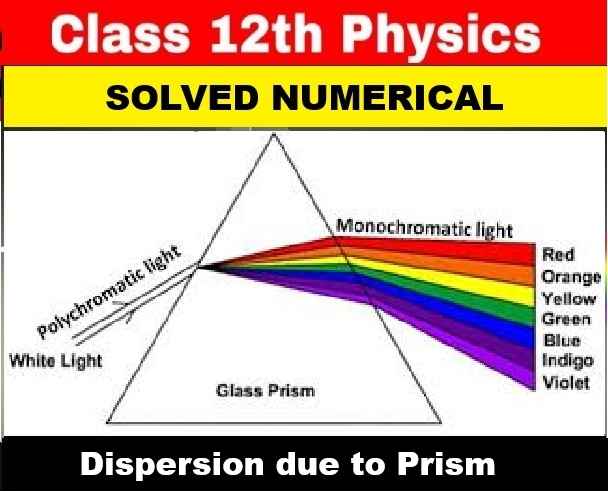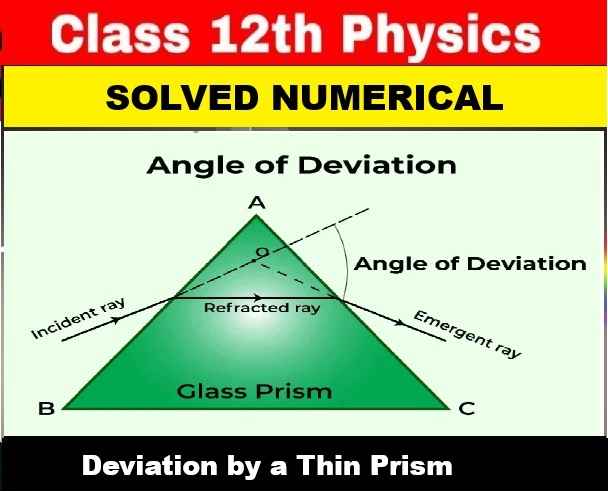Exercise-9B Household Circuits ICSE Class-10 Concise Physics Selina Solutions Chapter-9. We Provide Step by Step Answer of Exercise-9(A), MCQs-9(A) Exercise-9(B), MCQ-9(B) Questions of Exercise-9 Household Circuits ICSE Class-10 . Visit official Website CISCE for detail information about ICSE Board Class-10.
| Board | ICSE |
| Publications | Selina Publication |
| Subject | Physics |
| Class | 10th |
| Chapter-9 | Household Circuits (Exercise 9B) |
| Book Name | Concise |
| Topics | Solution of Exercise-9(A), MCQs-9(A) Exercise-9(B), MCQ-9(B) |
| Academic Session | 2021-2022 |
Exercise-9B Household Circuits ICSE Class-10 Concise Physics Selina Solutions Chapter-9
-: Select Exercise :-
Exercise-9(B), MCQs-9(B)
How to Solve Household Circuits ICSE Class-10 Physics
Focus on main circuit, switches, fuses, earthing, safety precautions, three pin plugs, colour coding of wires. Household Circuit diagram, two-way switch, staircase wiring, need for earthing, fuse, 3-pin plug and socket, , neutral and earth points in 3-pin plugs and sockets; safety precautions, colour coding of wires.
Chapter 9: “Household Circuits” Selina Solution of ICSE Physics for Class 10th
Excercise – 9 (B)
Page 227
Question 1
What is a fuse? Name the material of fuse. State one characteristic of material used for the fuse.
Answer 1
An electric fuse is a safety device, which is used to limit the current in an electric circuit. The use of fuse safeguards the circuit and appliances connected in that circuit from being damaged.
An alloy of lead and tin is used as a material of fuse because it has low melting point and high resistivity.
Question 2
Name the device used to protect the electric circuits from overloading and short circuit. On what effect of current does it work?
Answer 2
‘Fuse’ is used to protect electric circuits from overloading and short circuiting. It works on heating effect of current.
Question 3
Complete the following sentences:
(a) A fuse is a short piece of wire of high _________ and of material low _________.
(b) A fuse wire is made of an alloy of ________ and ________. If the current in a circuit exceeds the current rating of the fuse wire it _________.
(c)A fuse is connected in ________ with the ________ wire.
(d) Higher the current rating,_______ is the fuse wire.
(e) Live wire is also called __________ wire.
Answer 3
(a) A fuse is a short piece of wire of high resistance and of material low melting point.
(b) A fuse wire is made of an alloy of lead and tin. If the current in a circuit exceeds the current rating of the fuse wire it melts.
(c) A fuse is connected in series with the live wire.
(d) Higher the current rating, thicker is the fuse wire.
(e) Live wire is also called phase wire.
Question 4 (Exercise-9B Household Circuits ICSE )
Why is the fuse wire fitted in a porcelain casing?
Answer 4
The fuse wire is fitted in a porcelain casing because porcelain is an insulator of electricity.
Question 5
How is a fuse put in an electric circuit? State the purpose of using a fuse in a circuit.
Answer 5
The fuse wire is stretched between the two metallic terminals T1 and T2 in a porcelain holder (since porcelain is an insulator of electricity). This holder fits into a porcelain socket having two metallic terminals to which the live wires of the circuit are connected. The figure below is showing the fuse arrangement.
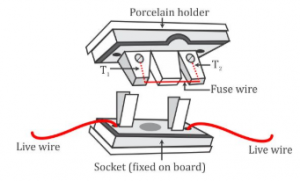
A fuse is connected with each electrical appliance to safeguard it from the flow of excessive current through it.
Question 6
Describe with the aid of a diagram some form of a fuse, which is used in the electric lighting circuit of a house. Give two reasons why a fuse must not be replaced by an ordinary copper wire.
Answer 6
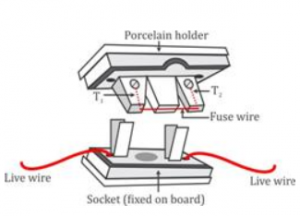
The figure above shows the most common fuse arrangement in which the fuse wire is stretched between the two metallic terminals T1 and T2 in a porcelain holder. This holder fits into a porcelain socket having two metallic terminals to each of which the live wire of the circuit is connected.
A fuse must not be replaced with a copper wire because copper has very low resistivity and high melting point.
Question 7
A fuse is always connected to the live wire of the circuit. Explain the reason.
Answer 7
The fuse wire is always connected in the live wire of the circuit because if the fuse is put in the neutral wire, then due to excessive flow of current when the fuse burns, current stops flowing in the circuit, but the appliance remains connected to the high potential point of the supply through the live wire. Now if a person touches the appliance, he may get a shock as the person will come in contact with the live wire through the appliance.
Question 8
How does the (i) thickness and (ii) length of a fuse wire depend on its current rating
Answer 8
The current rating of the fuse wire
(i) Is directly proportional to the thickness of the fuse wire. Thicker the fuse wire, higher will be the current rating of the fuse wire.
(ii) The current rating of the fuse wire does not depend on its length.
Question 9
Two fuse wires are rated 5 A and 20 A. Which of the two is (i) thicker, (ii) longer?
Answer 9
The 20 A fuse wire will be thicker so that its resistance be low.
5 A will be longer because length is directly proportional to resistance hence longer the wire greater will be the resistance smaller the current.
Question 10 (Exercise-9B Household Circuits ICSE )
Explain the meaning of the statement ‘the current rating of a fuse is 5 A’.
Answer 10
It means that the line to which this fuse is connected has a current carrying capacity of 5 A.
Question 11
(a) ‘A fuse is rated 8 A’. Can it be used with an electrical appliance of rating 5 kW, 200 V?
(b) Name two safety device which are connected to the live wire of a household electric circuit.
Answer 11
(a) The safe limit of current which can flow through the electrical appliance is I = P/V = 5000/200 = 25 A; which is greater than 8 A. So, such fuse cannot be used. (No)
(b) Switch and fuse.
Question 12
An electric kettle is rated 3 kW, 250 V. Give reason whether this kettle can be used in a circuit which contains a fuse of current rating 13 A.
Answer 12
Yes, this kettle can be used in a circuit which contains a 13 A fuse because safe limit of current for kettle is,

Question 13
(a) What is the purpose of a switch in a circuit?
(b) Why is the switch put in the live wire?
(c) What precaution do you take while handling a switch?
Answer 13
A switch is an on-off device for current in a circuit (or in an appliance). The switch should always be connected in the live wire so that the appliance could be connected to the high potential point through the live wire. In this position the circuit is complete as the neutral wire provides the return path for the current. When the appliance does not work i.e., in off position of the switch, the circuit is incomplete and no current reaches the appliance.
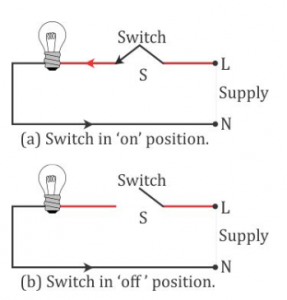
On the other hand, if switch is connected in the neutral wire, then in ‘off’ position, no current passes through the bulb. But the appliance remains connected to the high potential terminal through the live wire.

Thus, if the switch is connected in the neutral wire, it can be quite deceptive and even dangerous for the user.
(c) Precaution while handling a switch: A switch should not be touched with wet hands.
Page 228
Question 14
(a) A switch is not touched with wet hands while putting it on or off. Give a reason for your answer.
(b) Name the wire to which a switch is connected.
Answer 14
A switch should not be touched with wet hands. If water reaches the live wire, it forms a conducting layer between the hand and the live wire of the switch through which the current passes to the hand and the person may get a fatal shock.
Question 15 (Exercise-9B Household Circuits ICSE )
It is dangerous to connect the switch in the neutral wire. Explain your answer.
Answer 15
In case of excessive current, it is dangerous to connect the switch in the neutral wire.
Even if the fuse blows off due to excessive current and the current in the circuit would no longer be conducted, the appliance will still remain connected to the live wire of a very high potential.
In such a case, if a person touches the body of that appliance, he/she may suffer a fatal electric shock.
That is why it is highly dangerous to connect the switch with the neutral wire.
Question 16
Draw a diagram of a dual control switch when the appliance is switched ‘ON’.
Answer 16
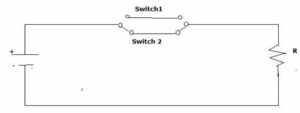
Question 17
Draw a circuit diagram using the dual control switches to light a staircase electric light and explain its working.
Answer 17
Let a switch S1 be fitted at the bottom and a switch S2 at the top of the staircase. Fig. (a) shows the off position of the bulb.
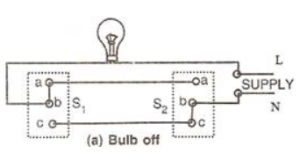
The bulb can now be switched on independently by either the switch S1 or the switch S2. If the switch S1 is operated, the connection ‘ab’ is changed to ‘bc’, which completes the circuit and the bulb lights up [Fig. (b)].
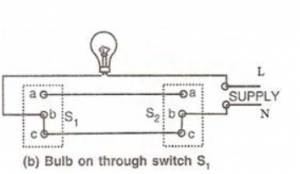
Similarly, on operating the switch S2, the connection ‘bc’ changes to ‘ba’, which again completes the circuit [Fig. (c)].
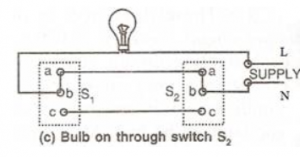
Similarly if the bulb is in on position as shown in Fig. (b) or (c), one can switch off the bulb either from the switch S1 or the switch S2.
Question 18
What purpose is served by the terminals of a three way pin plug? Draw a diagram and name the pins.
Answer 18
All electrical appliances are provided with a cable having a plug at one end to connect the appliance to the electric supply.
In this three way pin plug, the top pin is for earthing (E), the live pin (L) in on the left and the neutral pin (N) is on the right.
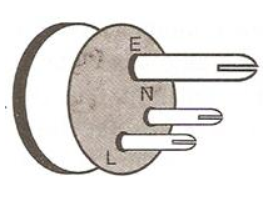
Question 19
The diagram in fig.9.26 shows a three pin plug. Label the three pins.
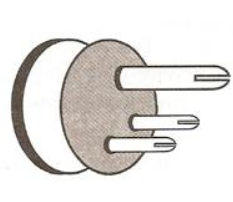
(a) Why is top pin thicker and longer than the other two?
(b) Why are the pins splitted at the ends?
Answer 19
The three pins in the plug are labelled as

Here E signifies the earth pin,
L is for live wire, and
N is for neutral wire.
(a)The earth pin is made long so that the earth connection is made first. This ensures the safety of the user because if the appliance is defective, the fuse will blow off. The earth pin is thicker so that even by mistake it cannot be inserted into the hole for the live or neutral connection of the socket.
(b)The pins are splitted at the end to provide spring action so that they fit in the socket holes tightly.
Question 20
Draw a labelled diagram of a three pin socket.
Answer 20
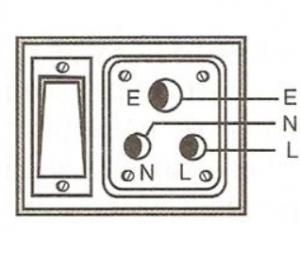
E: for earth pin
N: for neutral wire pin
L: for live wire pin.
Question 21
The diagram in Fig 9.27. shows a three-pin socket marked as 1, 2 and 3.
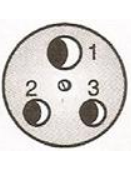
(a)Identify and write live (L), neutral (N) and earth (E) against the correct number.
(b)To which part of the appliance is the terminal 1 connected?
(c)To which wire joined to 2 or 3, is the fuse connected and why?
Answer 21
(a)1 – Earth, 2 – Neutral, 3 – Live
(b)Terminal 1 is connected to the outer metallic case of the appliance.
(c)The fuse is connected to live wire joined to 3 so that in case of excessive flow of current fuse melts first and breaks down the circuit to protect appliances.
Question 22 (Exercise-9B Household Circuits ICSE )
What do you mean by the term local earthing? Explain how it is done.
Answer 22
Local earthing is made near kWh meter. In this process a 2 – 3 metre deep hole is dug in the ground. A copper rod placed inside a hollow insulating pipe, is put in the hole. A thick copper plate of dimensions is welded to the lower end of the copper rod and it is buried in the ground. The plate is surrounded by a mixture of charcoal and salt to make a good earth connection.
To keep the ground damp, water is poured through the pipe from time to time. This forms a conducting layer between the plate and the ground. The upper end of the copper rod is joined to the earth connection at the kWh meter.
Question 23
To which wire is the metallic case of an electric appliance connected? give the reason?
Answer 23
If the live wire of a faulty appliance comes in to direct contact with the metallic case due to some reason then the appliance acquires the high potential of live wire. This may results in shock if any person touches the body of appliance. But if the appliance is earthed then as soon as the live wire comes in to contact with the metallic case, high current flows through the case to the earth. The fuse connected to the appliance will also blows off, so the appliance get disconnected.
Question 24
(a) The earthing of an electric appliance is useful only if the fuse is in the live wire. Given the reason.
(b) Name the part of the appliance which is earthed.
Answer 24
(a) The fuse must be connected in the live wire only. If the fuse is in the neutral wire, then although the fuse burns due to the flow of heavy current, but the appliance remains at the supply voltage so that on touching the appliance current flows through the appliance to the person touching it.
(b) Metallic case of the appliance should be earthed.
Question 25
For earthing an electrical appliance, one has to remove the paint from the metal body of the appliance where the electrical contact is made. Explain the reason.
Answer 25
The paint provides an insulating layer on the metal body of the appliance. To make earth connection therefore, the paint must be removed from the body part where connection is to be made.
Question 26
What is the colour code for the insulation on (a) live, (b) neutral and (c) earth wire?
Answer 26
According to new international convention
(a) Live wire is brown in colour.
(b) Neutral is light blue and
(c) Earth wire is yellow or green in colour.
Question 27
Name the colour code of the wire which is connected to (i) metallic body of an appliance, (ii) switch for the appliance.
Answer 27
Colour code of the wire which is connected to
(i) The metallic body of an appliance is the green coloured, earthing wire.
(ii) The switch of the appliance is the red coloured, live wire.
Question 28
How does the colour code of wires in a cable help in house wiring?
Answer 28
The colour coding of wires helps us to connect the switch, fuse, sockets, etc through proper wire in house wiring.
Question 29
A power circuit uses a cable using three different wires.
(a) Name the three wires of the cable.
(b)Between which of the two wires should the heating element of an electric geyser be connected?
(c)To which wire should the metal case of the geyser be connected?
(d)To which wire should the switch and fuse be connected?
Answer 29
(a) The three wires are: Live wire, Earth wire and Neutral wire.
(b)The heating element of geyser should be connected to live wire and neutral wire.
(c)The metal case should be connected to earth wire.
(d)The switch and fuse should be connected to live wire.
Question 30
State two circumstances when one may get an electric shock from an electrical gadget. What preventive measures must be provided with the gadget to avoid it?
Answer 30
One may get an electric shock from an electrical gadget in the following two cases:
(i) If the fuse is put in the neutral wire instead of live wire and due to fault, if an excessive current flows in the circuit, the fuse burns, current stops flowing in the circuit but the appliance remains connected to the high potential point of the supply through the live wire. In this situation, if a person touches the faulty appliance, he may get an electric shock as the person will come in contact with the live wire through the appliance.
Preventive measure: The fuse must always be connected in the live wire.
(ii) When the live wire of a faulty appliance comes in direct contact with its metallic case due to break of insulation after constant use (or otherwise), the appliance acquires the high potential of the live wire. A person touching it will get a shock because current flows through his body to earth.
Preventive measure: Proper ‘earthing’ of the electric appliance should be done.
Question 31 (Exercise-9B Household Circuits ICSE )
Why is it necessary to have an earth wire installed in a power circuit, but not in a lighting circuit?
Answer 31
Power circuit carries high power and costly devices. If there is some unwanted power signal (noise) in the wire it can damage the device. To reduce this effect earth is necessary.
Lighting circuit carries low power (current).So, we ignore the earth terminal.
Question 32
Give two characteristics of a high tension wire.
Answer 32
A high tension wire has a low resistance and large surface area.
Question 33
Which of the cables, one rated 5 A and the other 15 A will be of thicker wire? Give a reason for your answer.
Answer 33
To carry larger current, the resistance of the wire should be low, so its area of cross section should be large. Therefore 15 A current rated wire will be thicker.
Question 34
The diagram in Fig.9.28 shows three lamps and three switches 1, 2 and 3.
(a) Name the switch/switches to be closed so as to light all the three lamps.
(b) How are the lamps connected: in series or in parallel?

Answer 34
(a) Switches 2 and 3.
(b) The lamps are connected in series.
Page 229
Question 35 (Exercise-9B Household Circuits ICSE )
Figure below shows a dual control switch circuit use to light a bulb.

(a) Complete the circuit so that bulb is switched on.
(b) Mark the supply terminal with L and N to indicate live neutral wires
Answer 35
(a)
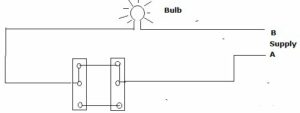
(b)
A is live
B is neutral.
Question 36
Fig. below shows two bulbs with switches and fuse connected to mains through a socket.
(a) Label each component – blub, switch , fuse and socket.
(b) Name and state the colour of insulation of each wire 1, 2 and 3.
(c) How are the two bulbs joined: in series or in parallel?

Answer 34
(a)

(b)
| Wire no. | Wire name | Colour (Old convention) | Colour (New convention) |
| 1 | Neutral wire | Black | Light blue |
| 2 | Earth wire | Green | Green or yellow |
| 3 | Live wire | Red | Brown |
(c) The bulbs are joined in parallel.
Chapter :- 9 “Household Circuits” Selina Physics Solutions
MULTIPLE CHOICE TYPE – 9 (B)
Page 229
Question 1
The rating of a fuse connected in the lighting circuit is :
(a) 15 A
(b) 5 A
(c) 10 A
(d) Zero
Answer 2
(b) 5 A
Question 2 (Exercise-9B Household Circuits ICSE )
A switch must be connected in :
(a) Live wire
(b) Neutral wire
(c) Earth wire
(d) Either earth or neutral wire
Answer 2
(a) In live wire.
Return to Concise Selina ICSE Physics Class-10
Thanks

